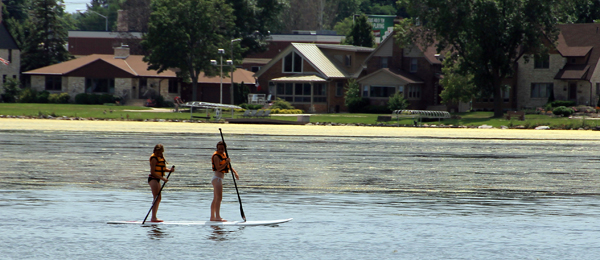news
![]()
January 15, 2014
Good news and bad news for reducing phosphorus in the lakes

 When it comes to reducing phosphorus in the Yahara lakes, there is good news and bad news, according to two recent papers co-authored by WSC PI Steve Carpenter and Richard Lathrop from the Wisconsin Department of Natural Resources.
When it comes to reducing phosphorus in the Yahara lakes, there is good news and bad news, according to two recent papers co-authored by WSC PI Steve Carpenter and Richard Lathrop from the Wisconsin Department of Natural Resources.
The good news is, if we can reduce the amount of phosphorus going into Lakes Mendota and Monona to about half the current levels and maintain the existing food web, we can substantially improve water quality.
The bad news is, up to 2010, phosphorus management practices have not succeeded in improving water quality. The findings suggest that more aggressive actions are needed to meet water quality goals for the lakes.
Even significant reductions in phosphorus pollution may not be enough for Lakes Waubesa and Kegonsa to meet their water quality improvement targets, however. As the lower lakes in the lake chain, Waubesa and Kegonsa are the recipients of whatever flows out of Lake Monona. A large phosphorus outflow, combined with sediments already backlogged with the nutrient, keeps Waubesa and Kegonsa’s phosphorus levels high.
Yet, management efforts may have countered several adverse trends that should have further worsened water quality, even though they did not decrease phosphorus levels. These trends include more manure from livestock farms, more precipitation from bigger storms, and more impervious surfaces, such as roads, parking lots, and roofs. Since phosphorus levels remained about the same, management efforts may have been sufficient to counter the trends’ effects.
Ongoing research by WSC and LTER, along with programs like Yahara Watershed Improvement Network (WINs), will help us better understand the interactions between these trends and management efforts.
Phosphorus pollution is the leading cause of poor water quality in the Yahara Lakes. Agricultural runoff—e.g., fertilizers and manure—is the primary source, but urban runoff also plays a role.
The studies appeared in the November 2013 volume of the International Society of Limnology’s journal, Inland Waters, and in the January 2014 volume of Aquatic Sciences.


